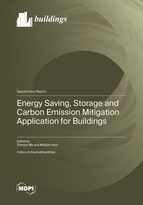Energy Saving, Storage and Carbon Emission Mitigation Application for Buildings
A special issue of Buildings (ISSN 2075-5309). This special issue belongs to the section "Building Energy, Physics, Environment, and Systems".
Deadline for manuscript submissions: closed (10 October 2023) | Viewed by 20356
Special Issue Editors
Interests: building big data analytics; building energy efficiency; HVAC control and optimization; desiccant cooling systems; thermal energy storage using phase change materials; solar photovoltaic thermal collectors
Special Issues, Collections and Topics in MDPI journals
Special Issue Information
Dear Colleagues,
The building sector is responsible for a significant proportion of global energy usage, and generates large quantities of greenhouse gas emissions. Buildings will play a key role in the transition to a low-carbon and clean energy future through deep decarbonization and assisting in achieving nations’ commitment to the Paris Agreement’s long-term temperature goal to limit global warming. This has intensified the calls for innovative technologies for increased energy efficiency, resilience and sustainability. This Special Issue aims to collect excellent research and review articles addressing global imperatives and stringent environmental standards related to energy and sustainability in buildings to meet the UN’s Sustainable Development Goals (SDGs). The potential topics of this Special Issue include, but are not limited to:
- Building energy-saving solutions and techniques.
- Energy storage technologies and applications in buildings.
- Building carbon emission mitigation strategies.
- Smart energy technologies.
- Building energy management solutions.
- Demand flexibility.
- Renewable energy in buildings.
- Advanced building heating, ventilation and air conditioning systems.
- Building big data analytics.
- Data-driven modelling.
Prof. Dr. Zhenjun Ma
Prof. Dr. Müslüm Arıcı
Guest Editors
Manuscript Submission Information
Manuscripts should be submitted online at www.mdpi.com by registering and logging in to this website. Once you are registered, click here to go to the submission form. Manuscripts can be submitted until the deadline. All submissions that pass pre-check are peer-reviewed. Accepted papers will be published continuously in the journal (as soon as accepted) and will be listed together on the special issue website. Research articles, review articles as well as short communications are invited. For planned papers, a title and short abstract (about 100 words) can be sent to the Editorial Office for announcement on this website.
Submitted manuscripts should not have been published previously, nor be under consideration for publication elsewhere (except conference proceedings papers). All manuscripts are thoroughly refereed through a single-blind peer-review process. A guide for authors and other relevant information for submission of manuscripts is available on the Instructions for Authors page. Buildings is an international peer-reviewed open access monthly journal published by MDPI.
Please visit the Instructions for Authors page before submitting a manuscript. The Article Processing Charge (APC) for publication in this open access journal is 2600 CHF (Swiss Francs). Submitted papers should be well formatted and use good English. Authors may use MDPI's English editing service prior to publication or during author revisions.
Keywords
- buildings
- energy storage
- demand flexibility
- energy management
- energy efficiency
- carbon emission mitigation







